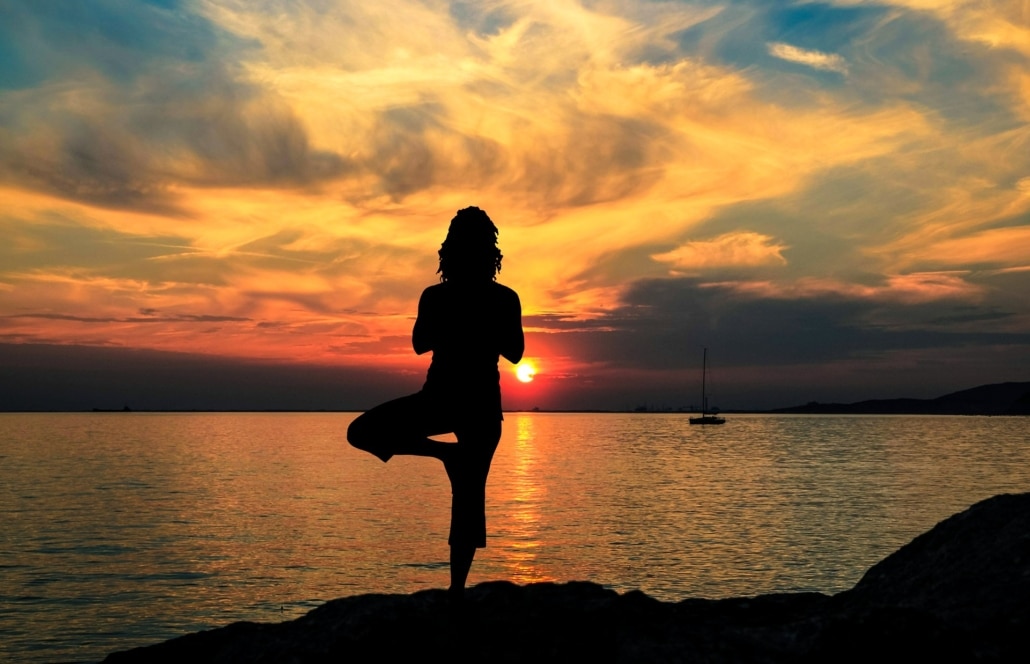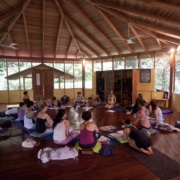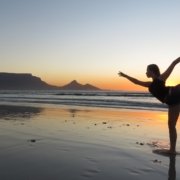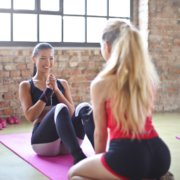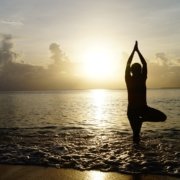11 Best Standing Yoga Poses (Standing Asanas)
Standing yoga poses are great for posture correction, balance improvement, and other therapeutic benefits. Performing standing poses regularly enhances blood circulation, particularly in the head and legs, which helps reduce the risk of developing conditions such as cervical pain, vein thrombosis, hyperextended knee, asthma, runner knee, heart attack, anxiety and cardiac arrest.
Some poses strengthen the Achilles tendon, hamstring, and hip flexor, so they are a good treatment for athletes, dancers, seniors, kids, and people with regular desk jobs. However, standing yoga poses can be quite challenging. They require leg strength, full-body flexibility, and the ability to balance oneself with one leg while moving gracefully between poses.
If one of the legs(standing) begins to shake, that’s a good indication of a person building muscle and strength. Looking for standing yoga poses to increase your balance and posture.? Here are some of the best standing yoga poses you should consider.
Mountain Pose
Mountain Pose, also known as Tadasana, is the base of all yoga postures and is ideal for every yoga beginner. It’s an excellent pose for improving stability, mental alertness, and relaxation. Because it requires little effort, every beginner should practice it as a way to rest, refocus and gain stability
Step by step instructions to rehearse Mountain Pose:
- Stand tall with your feet hips distance separated.
- Uniformly distribute weight on your two feet
- Move your shoulders back.
- Position your arms by the sides and palms facing downwards
- Fix your look forward or close your eyes
High Lunge Pose
High Lunge Pose invigorates the body besides strengthening the arms, legs, and stomach. It’s a superb option compared to Warrior 1 Pose, which we’ll also cover in this article. Although the High Lunge can be a challenging pose, it’s highly friendly to yoga beginners.
How to perform the High Lunge Pose:
- From Down Dog pose, put your put forward.
- Pile your knee over your front lower leg
- Stand tall and lift your back knee
- Use your core to lift your middle section or torso
- Raise the arms overhead, position your palms to centre
- Take 5-7 breaths on each side.
Awkward Chair – Utkatasana
Standing yoga poses strengthen and stretch group muscles in your thighs, legs, calves, and hamstrings. These muscles are probably the biggest muscles in the body, which help you tone and lose weight.
The Awkward Chair is an ideal standing yoga pose for beginners that everyone should start with. Bend both legs at the knee and focus your thighs, hip, and buttocks while ensuring your toes are pointed straight forward. Squat down to a position where your thighs and the floor are parallel. Raise your arm carefully to prevent shrugging your shoulders. Hold 5-10 breaths for best results.
Eagle Pose (Garudasana)
To perform garudasana:
- Focus your weight on one foot and lift the other foot slowly.
- Bend the standing foot at the knee, wrap your thighs and hook the other foot behind your calf.
- Once you achieve stability, bring your arms into the pose by wrapping them over the other and ensuring they palm touch each other.
- Hold up 5 to 10 breaths.
Tree Pose (Vrksasana)
Tree Pose (Vrksansana) is one of the most popular standing balance poses for beginners. The pose will help you learn how to stand with one leg, even though you’ll find it challenging, and most likely, you’ll wobble or fall at the beginning.
To perform this pose, feel the weight concentration on both your standing feet and ensure the weight is distributed equally on your feet. Shift your weight into one foot and lift the other foot off the floor. Keep your leg upright, and don’t lock your knee. Bend the other foot and bring your sole slowly into your inner thigh. Press the foot into your thigh and your foot into your thigh for increased pressure. This will ensure your hips are squared to the front and don’t stick out. Focus your gaze on nonmoving objects to keep your balance.
Standing Forward Bend (Uttanasana)
To perform the pose, bend forward at your hips, place your palm on the floor, and then move them slowly behind your heels. Standing forward bend lengthens and stretches your hamstring and calves. The pose can be a quick treatment for athletes, who tend to tighten their hamstrings because of lots of running. Besides, the pose can cure insomnia, relieve stress, and promote relaxation.
King Dancer Pose
King dancer poses to enhance your balance, work on your core, and stretches your shoulders. It’s an excellent exercise for opening the hip flexor, caused by sitting down for a long duration. With the King dancer pose, you need total focus and concentration. To perform the pose, stand tall with both feet with weight equally distributed.
Shift weight on one foot, bend and lift the other foot off the floor. Bring your knee to touch your midline. Grasp your lifted foot with your hand and ensure your thumb rests on your foot sole, pointing to the direction of your toes. Lift your arm upwards towards the ceiling. Lift your left behind and bring your torso. Fix your gaze on nonmoving objects to remain focused. Hold 5 to 10 breaths per session.
Warrior 2 Pose
Warrior 2 Pose, or Virabhadrasana II, derives its name from the Hindu mythical warrior, Virabhadra.
It strengthens your legs and the abs, besides stretching the hips. This posture is also known for enhancing your confidence, so it works well for both the body and mind. Warrior 2 is an enjoyable and powerful standing yoga posture for beginners to consider whenever they want to uplift their moods.
How to rehearse Warrior 2 Pose:
- Position yourself in High Lunge Pose
- Turn your back foot at 45 degrees, so your back foot’s curve is parallel with your front foot heel.
- Thrust into your front leg while keeping the knee stacked over your ankle front
- Connect with your core to position your torso upright
- Open your hips along the mat’s edge
- Spread your arms in the opposite direction like wings with the palms pointing to the ground
Extended Side Angle Pose
Hold for 5-8 breaths on the two sides.
Extended Side Angle Pose, also referred to as Utthita Parsvakonasana, helps stretch your shoulders and the upper back. It is also great for toning and strengthening the legs and abs.
How to rehearse the Extended Side Angle Pose:
- Position yourself in Warrior 2 Pose
- Carry your front elbow towards your front thigh
- Stretch your opposite arm forward over your ear or straight up, though it depends on the flexibility of your shoulder
- Look skyward
- Hold for 5-7 breaths on the two sides.
Triangle Pose
Triangle Pose, also known as Trikonasana, eases back pain – particularly for people who experience sacroiliac joint pain or suffer from sciatica. It also hardens the legs and makes the hips more flexible. This standing amateur yoga pose is highly beneficial to your health.
How to perform the Triangle Pose:
- Position yourself in Warrior 2 posture
- Let your feet remain as they are, and straighten your legs.
- Spread front arm forward to a point your feel your back hip is stretched
- Let front arm lay on your front thigh, floor, or shin
- Bring the opposite arm upwards like a wing shape.
- Fix your gaze at the top hand
- Hold breath 5-8 times on both hands.
Standing yoga poses strengthen and stretch group muscles in your thighs, legs, calves, and hamstrings. These muscles are probably the biggest muscles in the body, which help you tone and lose weight.
Downward Dog (Adho Mukha Svanasana)
This is a famous yoga pose for beginners and is usually used as warm in most yoga classes. It’s great for stretching your legs and back while stretching your arms and shoulders.
How to perform Downward dog pose
- Begin by placing your hand on knees, ensure your shoulders align with your wrist and your hips are over your knees.
- Raise your hips, slightly bend your knees
- Straighten your arms, move your shoulders outward and lift your hips high
- Straighten your leg and begin lowering your heels to the floor
- Hold breath 5 to 8 breaths.
How to maintain Good Posture
There are several checkpoints you need to be aware of when maintaining a good posture. Ding yoga poses and listening to your body is the key to having good posture, balance, and stability.
- Foot and ankle: Your feet ought to be in light with shoulders with both toes moving forward
- Knees: Your knees should always alight with your toes when walking
- Pelvis: Your pelvis should be aligned correctly. Watch out for lumbar flexion(flat back) or lumber extension(lordosis)
- Shoulders: Your shoulders should be level not tilted upward or forward.
- Head: Your head should not be titled or protruding forward.
These yoga standing poses can improve your posture, stability, boost blood circulation and improve your overall health. Where you’re a beginner or intermediate yoga practitioner, practice the poses above and see your health and life quality improved dramatically. If you’re feeling adventurous you can also book a trip to our yoga and meditation retreat, based in the heart of the Rainforest, and be taught first hard by leading yoga teachers how to reduce stress and improve wellbeing.

